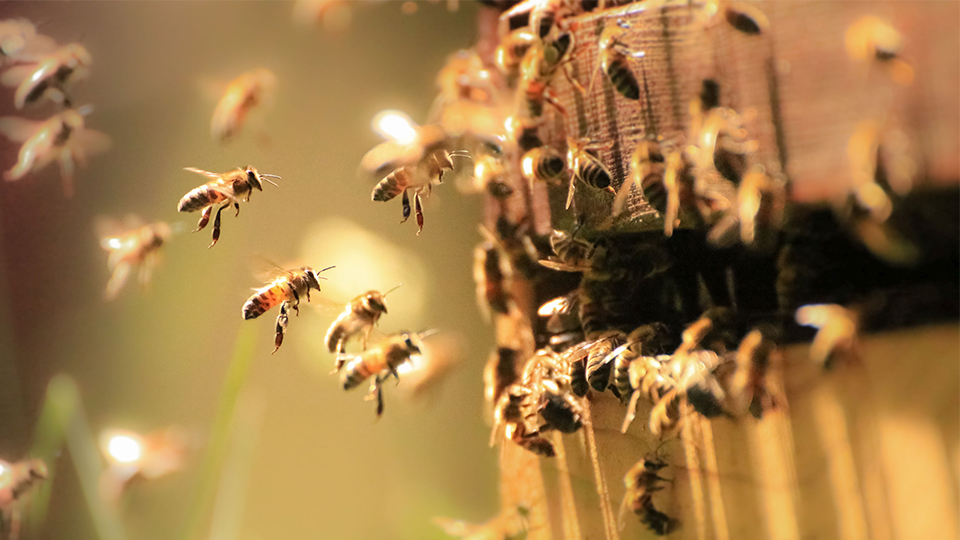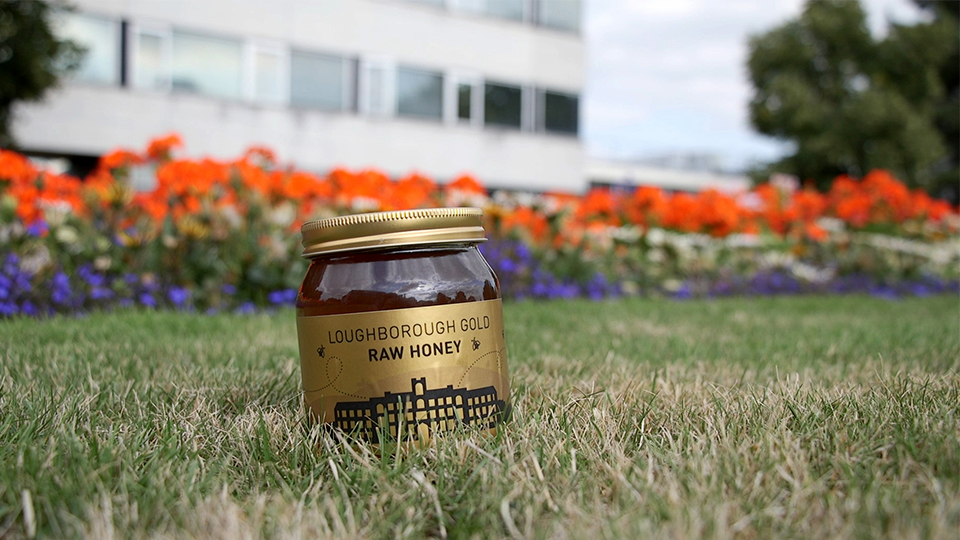Nestled in a quiet corner of Holywell Park are a number of flourishing colonies that make-up the volunteer-run Loughborough Apiary.
The University first welcomed honey bees in 2013 in a bid to support the declining bee population whilst increasing pollination and biodiversity on campus.
A bonus of having so many buzzing friends is that they produce honey, which the apiary volunteers harvest during the summer months.
This year, the team has been able to extract around 250lbs of ‘Loughborough Gold’ and will be selling jars on campus on Tuesday 18 September.
To celebrate the successful crop and thriving apiary, two academics have shared their un-bee-lievable research.
Dr Joan Fitzpatrick, a Senior Lecturer in English whose recent books include A History of Food in Literature and Three Sixteenth-Century Dietaries, has examined the use and value of honey in history.
Honey was praised by our ancestors long before sugar became widely available and has for centuries been celebrated in literature, not just for its natural sweetness, but for its nutrition and healing powers.
Dr Fitzpatrick said: “Honey has long been considered medicinal. Thomas Elyot’s Castle of Health of 1537 – a popular guide on how to maintain a healthy life – is typical of early modern views about honey, observing that ‘[it] is of incomparable efficacy for it not only cleanseth, altereth, and nourisheth but also it long time preserveth that uncorrupted which is put into it’.
“Elyot describes how honey makes all sorts of ‘liquors commodious to mankind’ and he also recounts how Democritus – a philosopher from ancient Greece who lived to be over 100-years-old – claimed that the secret to a long and healthy life was to ‘moisten the inside [of his body] with honey and the outside with oil’.
“In another popular dietary, The Government of Health of 1558, William Bullein thought honey especially suitable for old people ‘for it doth warm them’ and helps them make ‘good blood’.”
Honey is also mentioned in the works of great writers such as William Shakespeare and Ben Jonson, says Dr Fitzpatrick.
Shakespeare repeatedly refers to the sweetness of honey and sugar in his play Love’s Labour’s Lost, which was first performed in 1595 and in 1598 Francis Meres, an early admirer, referred to Shakespeare as ‘honey-tongued’.
Topical applications of honey can be found in Ben Jonson’s play Bartholomew Fair, first performed in 1614.
Ursula – the woman selling pork at the fair – is assured when she cuts her leg that the injury can be remedied ‘with the white of an egg, a little honey, and hog's grease’.
For some time, sugar was also considered beneficial to health; it had a high status until the early 18th century when the negative effects upon the body became increasingly apparent and it started to be associated with the slave trade.
Literature such as Christina Rossetti’s poem ‘Goblin Market’ of 1862 started to refer to sugar in a negative context, but honey kept its respected status.
Dr Fitzpatrick said: “Unlike sugar, honey has retained its appeal as a natural and healthy foodstuff redolent of a rural idyll.”
Honey has also long been reputed as a sacred food, says Dr Fitzpatrick, and in the Bible food sent by God to feed the children of Israel in the desert known as ‘manna’ is described as tasting ‘like wafers made with honey’.

Professor Barry Bogin has also found honey to be connected to religion and health in his research that focuses on ancient and modern Maya communities of Yucatan, Mexico and Guatemala.
The Professor of Biological Anthropology says honey harvests are followed by offerings and ceremonies of thanks and a page from the Dresden Codex – the oldest surviving book from the Americas, dating to the 13th or 14th century – presents Maya bees as deities associated with all powers that come from earth.
The Maya honey bee – called Xuna’an Kab (Royal Lady) in the Yucatec Maya language – is a stingless species (Melipona maya) that makes its home inside the cavities of tree trunks.
A designated bee guards the sole entrance, allowing only the inhabitants of its ‘hobón’ – the trunk that houses this hive – to come and go.
Both ancient and modern Maya appreciate the honey’s medicinal and regenerative properties, by itself or in combination with other flowers and herbs, says Professor Bogin.
He said: “The Maya consumed it in a specific manner: a spoonful every morning was prescribed because they considered it a medicine. They also ate it together with cassava, sweet potato or pumpkin as a dessert.
“The high quality of the honey is due to the two specific flower varieties dzidzilché (Gymnopodium floribundum) and ja’bín (Piscidia piscipula) frequented by the bees. The flavour of the honey is very sweet with floral notes.”
Professor Bogin continued: “Harvesting honey has always been accompanied by worship, prayers and offerings of thanks.
“The offering would often be a mildly alcoholic honey wine called balché prepared with the roots and bark of the balché tree (Lonchocarpus violaceus).
“Other offerings are leaves of the ja’bin plant, bits of the hobón itself, and candles of Campeche wax.
“Maya also offer a small sacrifice of blood, by pricking their tongue, ear or fingertips and to this day, ceremonies of thanks are still performed.”
It is nearly impossible to find genuine Maya honey for sale outside of the communities, says Professor Bogin, and it is becoming even harder as many Maya beekeepers have switched to raising European bees instead of the native species as increased droughts have affected local flora.

Though not as rare as Maya honey, Loughborough Gold is also hard to come by. It is sold in small batches as the apiary volunteers only take the excess honey produced so not to affect the bees.
Around 360 large, medium and small jars, adorned with new branding, will be on sale on Tuesday 18 September at the Sustainability Building between noon and 2pm with prices ranging from £1 to £7.50.
Commenting on the Loughborough honey project, Sustainability Manager Jo Shields said: “Being sustainable is about considering the environment around us and how everything is intrinsically linked. One thing relies on another thing to survive and flourish.
“The bees are a good mirror for this as they help complete the cycle required to maintain the beautiful green campus we live, work and play on.
“This is not without considerable help from the apiary volunteers – made up of staff and students - who work very hard over the main season to look after the bees and extract the honey before putting the bees to bed for winter!”